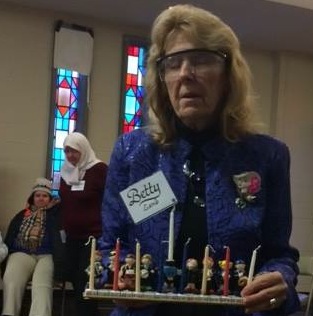Our program was an informal discussion about how light has informed our paths as shaped by our religions, cultures and beliefs.
Penny Hart, a United Methodist minister, spoke about the Christian season of Advent, the four Sundays leading up to Christmas, as a period of waiting and anticipation. Penny brought a candle holder with space for five candles representing Hope, Love, Joy (always pink), and Peace. The fifth candle (always white) is Christ’s candle. Typically these candles are arranged in a wreath symbolizing the eternity of God with the Christ candle in the center. A member or family in the congregation will light a new candle each Sunday in Advent—the Christ candle is lit on Christmas Eve symbolizing the light of Christ coming into the darkness of our world. Scriptural readings accompanying candle lighting focus on the story and meaning of Christmas.
Carol Lipson brought a menorah. Light is important in Jewish worship. Each temple has an eternal light just above the Torah; this symbolizes God and can never be let to go out. Hanukkah celebrates a time when the Assyrian occupiers demanded that Jews honor pagan gods. The Maccabee brothers and their father resisted the Roman demand, fought them and won. The oil they managed to get to light the temple lamp miraculously lasted for eight days instead of one, so Hanukkah is celebrated for eight days. The “helper candle” (middle, highest one) is used to light the rest, from right to left, one candle each night as special prayers are recited. Candles are left to burn down, and the glow makes this holiday really special. Carol has a menorah for each grandchild so each can light his/her own. As oil plays an important part in Hanukkah story, fried foods and desserts are prepared. While gift giving is not central to Hanukkah, it has been added because Christians give gifts at this time of year. Children play a dreidel game.
Betty Lamb brought in a menorah where the candles holders were figures on a keyboard. She played a humorous story on tape entitled “The Two Menorahs” from the book “Hanukkah Lights.” In it, two old friends argued about the two different schools of thought, one from Rabbi Hillel and the other from Rabbi Schmai, on the proper order in which to light the menorah candles and whether or not the menorah needs to be displayed in an outside window.
Danya Wellmon, Diane Lansing and Sue Savion talked about the centrality of light in Wiccan/Pagan rituals. While practices differ by sect, all Yule and Solstice ceremonies involve the leaving of the light (entering darkness) and return of the light in the spring. The Roman Sun Goddess’ birthday was December 25; under the Roman emperor Constantine, the Christian Church declared that date to be Christ’s birthday as well. Another Pagan tradition incorporated into Christmas is the lit Christmas tree; a tree brought into homes and lit with candles was thought to protect against devils.
Diane also referenced the 1993 Billings, Montana hate crime incident; a brick was thrown through the window of the home of a five-year-old Jewish boy who was displaying a menorah there. In response, Christian Sunday schools and town leaders banded together to say “Not in Our Town” and stand up for tolerance and compassion.
Joy Pople noted that in the modern world light pollution usually blocks our view of the stars. Thankfully, there are places in the United States, such as Oklahoma’s tall grass prairie or Bryce Canyon, that are still dark enough to display the splendor of the stars in the Milky Way. Barb Bova shared a personal story about how the light of candles and a glowing fireplace can bridge family and holiday tensions in a way that transcends any one religious tradition.

